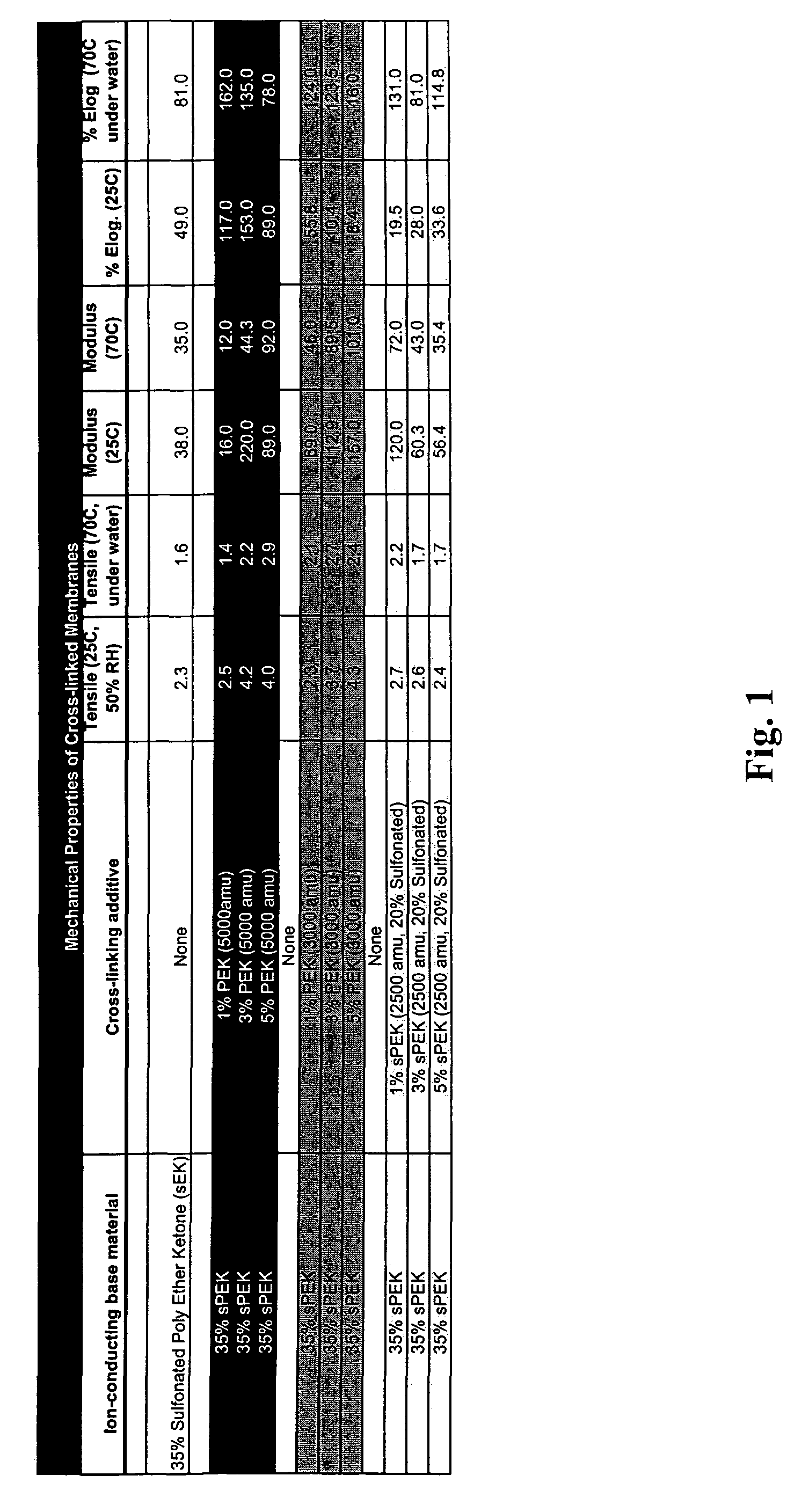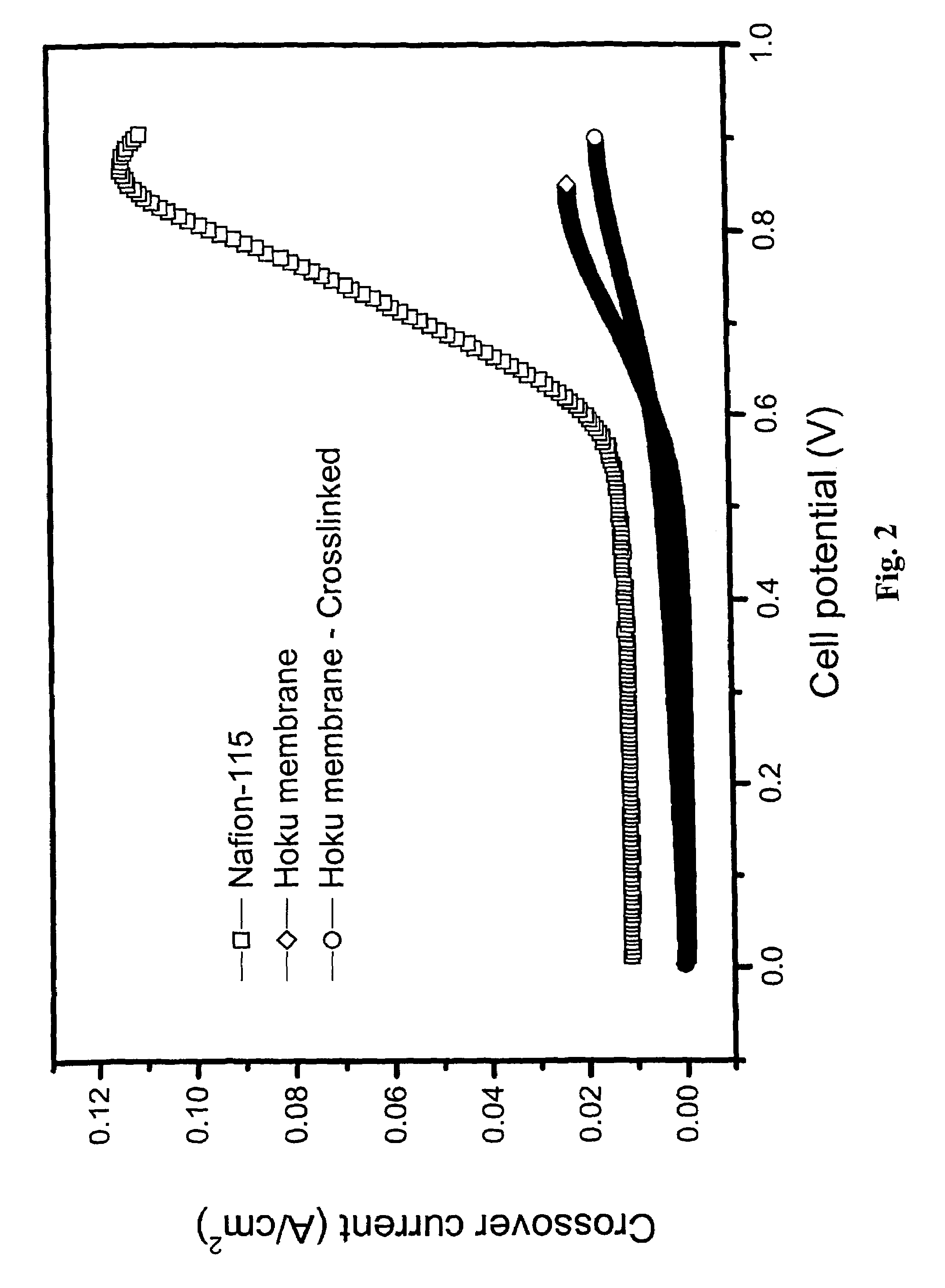Composite electrolyte with crosslinking agents
a technology of crosslinking agent and electrolyte, which is applied in the field of ionomers, can solve the problems of high production cost, high methanol permeability, and no material has met all the requirements, and achieves the effects of improving fuel cell performance metrics over the base material, improving physical and chemical stability, and low cos
- Summary
- Abstract
- Description
- Claims
- Application Information
AI Technical Summary
Benefits of technology
Problems solved by technology
Method used
Image
Examples
example 1
[0064]A first example describes the process of fabricating a crosslinked electrolyte material containing an organic cation exchange material. An aromatic polymer base material, di-sulfonated poly ether ketone with a molecular weight of over 60,000 amu is fabricated as described in US Pat. App. No 2002 / 0091225 A1. The material's degree of sulfonation is calculated based upon the ion-exchange capacity after the material is protonated via refluxing in 0.5M sulfuric acid. The protonated polymer is then thoroughly dried under vacuum.
[0065]A crosslinking agent of phenol terminated poly-ether ketone with a molecular weight of 2500 amu is fabricated and dried similarly to the method described in US Pat. App. No. 2002 / 0091225 A1. The dry base polymer and crosslinking agent are then combined in a high boiling solvent such as DMSO. The solution is azeotrophically distilled with toluene in a dean-stark apparatus between 135° C. and 175° C. for four hours. The toluene is then removed and the rea...
example 2
[0066]A second example describes the process of fabricating a functionalized crosslinked material: A commercially available polymer material (PEEK from Victrex) is dissolved in concentrated sulfuric acid and allowed to sulfonate for a given period of time under constant temperature. The polymer is then precipitated in ice water and rinsed until the wash water is neutral and then dried under vacuum. The phenol sulfonated crosslinking agent is then synthesized by copolymerization of sulfonated difluorodiphenol ketone and bis-phenol A. The molar ratio of each monomer is used to calculate the resulting molecular weight of the crosslinking component as well as its sulfonation level. The resulting crosslinking component consisting of phenol terminated polymer chains are then rinsed and dried under vacuum.
[0067]The sulfonated polymer base material is then combined with the sulfonated crosslinking agent and dissolved in DMSO. The ratio of polymer base material to crosslinking agent is calcu...
example 3
[0069]A third example shows that, by comparison, sulfoamide linkages are also formed via the direct crosslinking of sulfonic acid functional groups to amine terminated crosslinking agents. The crosslinking reaction may proceed identically to method detailed in Examples 1 and 2 with no changes in reaction conditions or compositions. The resulting gel may be cast in a manner as described above. The sulfoamide crosslinked membrane can then be prepared for its incorporation into a fuel cell or further physical and electrochemical tests.
PUM
| Property | Measurement | Unit |
|---|---|---|
| thickness | aaaaa | aaaaa |
| thickness | aaaaa | aaaaa |
| physical | aaaaa | aaaaa |
Abstract
Description
Claims
Application Information
 Login to View More
Login to View More - R&D
- Intellectual Property
- Life Sciences
- Materials
- Tech Scout
- Unparalleled Data Quality
- Higher Quality Content
- 60% Fewer Hallucinations
Browse by: Latest US Patents, China's latest patents, Technical Efficacy Thesaurus, Application Domain, Technology Topic, Popular Technical Reports.
© 2025 PatSnap. All rights reserved.Legal|Privacy policy|Modern Slavery Act Transparency Statement|Sitemap|About US| Contact US: help@patsnap.com



